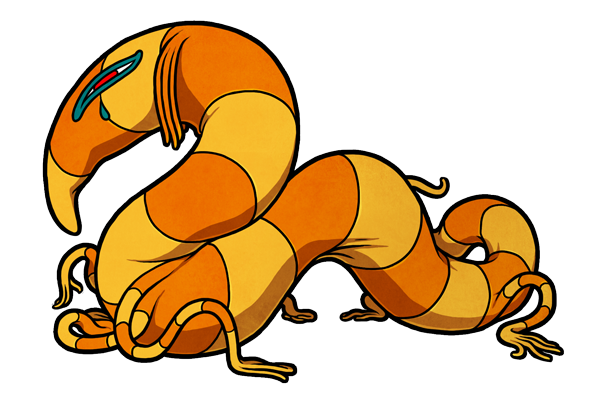

limnilandri
the ides
prefix limni suffix landri
monsancus spius
physical appearance
The limnilandri /ˌlɪmnəˈlændɹi/ is a stranger with a curved head, between three and five pairs of thin limbs, and two drooping appendages positioned behind its eye markings. A thin but durable skin, rubber-like in most ways, protects an inner, flesh-like structure analogous to brain tissue in appearance, but not composition.
The limnilandri tends to absorb other odors within its vicinity, leaving the air with only an inoffensive, sawdust-like scent.
muffled but persistent humming sounds.

environment and generation
The limnilandri appears in underground chambers of a less rigorous but analogous criteria to the ladroni's own, its generation similar in swell and duration.
Limnilandri that appear in ladroni-generating spacesϢ possess near-far vision, while limnilandri that appear in spacesⱹ that do not support a ladroni infestation possess near vision.
Ϣ
1 the trainstation emptywall
2 the sewer-line holding bay
3 the sealed chasm
ⱹ
1 the deadgarden
2 the future kaleidobar
3 the old bridge gap
behaviour
The limnilandri is single-minded, but unhurried in its goals. Within a city, it travels in non-looping paths, pausing for serious impediment, but ignoring all else.
The limnilandri is unable to display strength without a marked diminishment of firmness somewhere else in its body. Pushing with the forearms may cause its tail to grow limp, while ramming something with its head might force its legs to crumple beneath it. The limnilandri thus balances its movements in order to maintain its rigidity and allow this trait to remain visually unknowable.
When one limnilandri meets another, the two exchange a series of furtive touches to the face and neck. Larger individuals also touch the facial appendages of all smaller individuals, causing the smaller some discomforted squirming, but no abrupt social malaise.
When on the roam, the limnilandri is hunted by larger predatory stains, becoming coy in their presence, but succumbing in nearly all attacks.
adjustment of ladroni
The limnilandri seeks out and preys upon ladroni, doing so in an obsequious manner. During this hunt, the limnilandri make itself indistinguishable from the ladroni in behaviour, mimicking and contrasting its motions and deriving no suspicions from the individuals which it imitates. It shuffles closer with each rolling sway, until it is close enough to reach out and touch the ladroni's body with one of its appendages. This physical contact causes the ladroni to grow limp, all further actions terminated. This effect, however, does not kill the ladroni, which continues to live out the remainder of its natural lifespan in this inactive state.
Other ladroni tend to remain nonplussed by the limnilandri's continued presence, thus enabling the limnilandri to slaughter them into ultimate placenscy with ease, leaving behind a chamber known as a "dead cathedral". Within a dead cathedral, the limnilandri is not preyed upon by predatory strains. The limnilandri assumes occupancy within the dead cathedral for a span of several years, defending this area with force in the case of other wandering limnilandri. The limnilandri commits violence against other limnilandri only when defending such a territory.
The limnilandri displays attention to the inert ladroni within the dead cathedral, propping them up or repositioning them at various intervals, and with occasional manipulation of the limbs or mouths in a puppet-like manner. Otherwise, the limnilandri's swaying and imitation of the ladroni's motions continues with decreasing attention to impersonation, these dances punctuated by lulls of dreamy stupor.
The death of all ladroni within a cathedral forces the limnilandri on the roam once more.
interactions with sensitives
The limnilandri is indifferent to sensitives, admiring them with curiosity, but neither following nor avoiding them. If attacked, it grips the sensitive upon the forearm or leg, or around the neck or waist. Despite its sagging of form at the exertion, the limnilandri's strength is that of approximately two to three average-sized humans. Its touch causes numbness, paralysis, and loss of consciousness within the minute, and awareness remains subdued for exactly 34 hours, during which the limnilandri drags the sensitive with it; while carrying a sensitive, the limnilandri is avoided by all predatory strains.
The limnilandri offers𐐊 the sensitive to any ladroni that it encounters, leaving the ladroni's lair once it has let go of the sensitive.
Once a sensitive awakens from a limnilandri encounter, it is never bothered by subsequent limnilandri, nor does it face any further predation from the ladroni, with ladroni appearing blind to the sensitive's presence.
aging and death
During the last period of the limnilandri's life, the brain-like forms within the limnilandri's body rot from the tail up, becoming a porridge-like meal carrying with it a burnt and sour odor. Though its body droops and its motions grow more sloppy for it, its behaviour resists any impediment. The place between its eye markings is the last place to rot, and once the final bead of remaining matter is tainted with this decay, the limnilandri becomes limp. While its skin retains its rubbery consistency for many years, its innards become toxic in their enclosure. When it bursts, it brings forth an expulsion of colorless but astringent-smelling gas which dissipates after 69 days.
The limnilandri is unconcerned by the corpses of others of its strain, its curiosity limited to a clutching of the ear-like appendages, or a lifting of the limbs.



